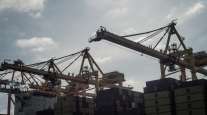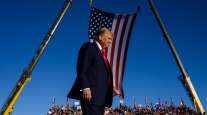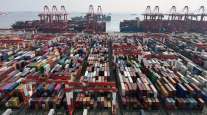China Looks Unlikely to Give In After US Tariff Hike

BEIJING — China unveiled a slew of changes under mounting pressure from U.S. President Donald Trump over technology.
Beijing promised to cut tariffs, open its auto industry and buy American exports. But none of that was what Trump wanted: an end to development policies Washington says are based on theft of know-how and might erode U.S. industrial leadership.
Exporters scrambled to replace lost orders after Trump pulled the trigger in July with his first round of tariff hikes on $50 billion of Chinese imports. Waves of job losses loom over factory towns. So far, however, Chinese leaders express confidence in their $12 trillion-a-year economy and are refusing to budge on tactics they see as a path to prosperity and global influence.
The communist leadership appears no more likely to back down after Trump escalated their dispute Sept. 17 by approving penalties on an additional $200 billion of Chinese goods, according to economists, political analysts and business groups.
“Contrary to views in Washington, China can — and will — dig its heels in,” William Zarit, chairman of the American Chamber of Commerce in China, said in a statement. “We are not optimistic about the prospect for a resolution in the short term.”
Trump’s complaints strike at the heart of the Communist Party’s view of itself as economic development leader — a venture capital investor on a national scale, boldly creating new industries.
That role has gained prominence since President Xi Jinping took power in 2012, despite the party’s 2013 pledge to give market forces a “decisive role” in the state-dominated economy.
Reform advocates complain state-owned companies that dominate banking, energy and other industries are getting bigger. They say that ignores the lessons of three decades of market-style changes that propelled China’s economic boom.
Beijing still is figuring out what Washington wants, Citigroup economist Li-Gang Liu said.
“The bottom line from the U.S. side is not clear,” Liu said in an e-mail. “Without clarity as to what President Trump wants from the Chinese exactly, it is difficult to see any progress ahead.”
The ruling party sees initiatives including “Made in China 2025,” which calls for state-led creation of global champions in robotics, electric cars and other fields, as essential for raising incomes for China’s poor majority and restoring the country to its historic status as a technology and cultural leader.
Washington, Europe and other trading partners complain that explicitly nationalistic goals of creating Chinese global brands and promise subsidies to local competitors violate Beijing’s promises to treat companies equally. American officials also say Beijing steals or pressures foreign companies to hand over technology.
While rebuffing U.S. pressure, Beijing has unveiled other changes long sought by its trading partners.
The government announced in April it would allow full ownership of electric car manufacturers beginning this year and lift all ownership caps in the industry by 2020. Beijing agreed to join the European Union in proposing reforms of the World Trade Organization, which Washington complains is antiquated and unable to cope with Chinese-style challenges.
Chinese leaders appear to be wrestling with how to present their plans in a way that causes less foreign opposition, said Paul Haenle, director of the Carnegie-Tsinghua Center for Global Policy. He said there was “considerable debate” about how to handle Washington at the leaders’ annual summer retreat at the seaside resort of Beidaihe.
“I do think there is some internal debate about, ‘Did we handle this right? Is there some way we can acknowledge to the U.S. side and others that we recognize there are changes we need to make?’ ” Haenle said. But doing that without looking like Chinese leaders are “caving in to the United States will be a difficult endeavor to pull off.”
Chinese leaders might have hoped cooperating on North Korea would win over Trump. But he went ahead with tariff hikes even after Beijing joined the “maximum pressure” campaign on North Korean leader Kim Jong Un to give up nuclear weapons and Xi skipped the regime’s 70th anniversary festivities this month.
“I don’t think they have any great hopes that Trump is going to be any easier on them,” Haenle said.
Beijing’s conviction that it needs to accelerate technology development was reinforced by this year’s near-death of ZTE Corp., one of China’s biggest tech companies, Citigroup’s Liu said.
ZTE announced it might shut down after Washington imposed a seven-year ban on sales of U.S. components and technology to the state-owned manufacturer of telecoms equipment, citing its exports to North Korea and Iran. To regain access, ZTE agreed to pay a $1 billion fine, replace its executive team and embed a U.S.-chosen compliance team in the company.
Chinese leaders realized “they don’t have core technology,” Liu said. Made in China 2025 has “become more important than before and will be accelerated.”
Some Chinese reform advocates see a possible way out: Restructure Made in China 2025 and other initiatives to make them more market-oriented and strip out subsidies that irk Washington and other governments. They say that would pay dividends for China by encouraging creativity and efficiency through competition.
“That would be nothing more than promising further opening and reform. Government interference in business would be corrected,” Beijing economist Hu Xingdou said. “These are all good for the Chinese people.”
Beijing might hope Trump will “move to a more conciliatory position,” especially if his Republican Party suffers setbacks in November elections, Haenle said. But he said they doubt they know enough about American politics to try to influence the outcome by offering concessions.
The impact on China has been smaller than some American leaders hoped.
The tariff hike Sept. 17 might trim China’s economic growth by 0.3 to 0.5 percentage points over the next year, Lillian Li of Moody’s rating agency said in a report. But government stimulus spending and easier credit should offset that, leaving China’s growth forecast unchanged at 6.6% this year and 6.4% in 2019, she said.
Citigroup estimates the first U.S. tariffs on $50 billion of Chinese goods will wipe out about 881,000 industrial jobs. That could rise to 3.5 million additional lost jobs over three to five years if the tariffs on $200 billion of imports increase to 25%, it said.
The dispute has a silver lining for some Chinese companies as some local governments act on long-standing complaints by cutting taxes and fees and simplifying bureaucracy.
Guangdong province, an export center adjacent to Hong Kong, announced changes Sept. 10 that it said would cut costs for businesses there by 200 billion yuan ($31 billion) in 2018-20.
“We believe Chinese industries will come out of the trade war stronger than before,” Citigroup’s Liu said.
AP researcher Yu Bing contributed to this story.




